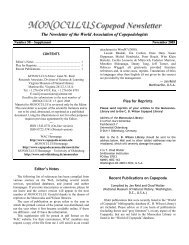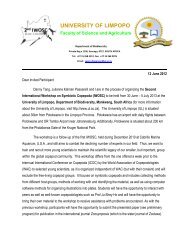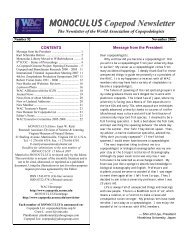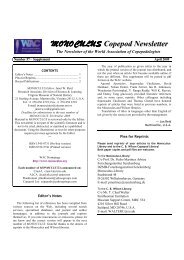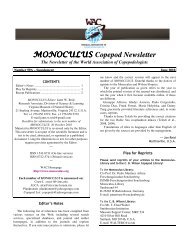MONOCULUS Copepod Newsletter - World Association of ...
MONOCULUS Copepod Newsletter - World Association of ...
MONOCULUS Copepod Newsletter - World Association of ...
Create successful ePaper yourself
Turn your PDF publications into a flip-book with our unique Google optimized e-Paper software.
Bob Kabata Receives the Order <strong>of</strong> Canada<br />
Zbigniew Kabata, C.M., D.Sc.<br />
In May, the WAC's first President Bob Kabata was<br />
appointed a Member <strong>of</strong> the Order <strong>of</strong> Canada (C.M.). The<br />
text <strong>of</strong> the award is as follows:<br />
“Bob Kabata is an internationally renowned authority on<br />
the biology <strong>of</strong> marine parasites and was the long-standing<br />
head <strong>of</strong> Parasitology research at the Pacific Biological<br />
Station in Nanaimo. His groundbreaking research, spanning<br />
over five decades, has greatly improved our understanding<br />
<strong>of</strong> marine ecology and has had a significant worldwide<br />
impact on the management <strong>of</strong> commercial fisheries.<br />
Undeterred by retirement, he actively pursues his research<br />
and remains an eminent authority in this important field <strong>of</strong><br />
biological study.”<br />
An all-too-brief biography is available on Wikipedia at<br />
http://en.wikipedia.org/wiki/Zbigniew_Kabata<br />
New Books and Websites: Reviews<br />
Crustacea, <strong>Copepod</strong>os marinos I.<br />
Calanoida<br />
By Francisco Vives & Alexandra A. Shmeleva<br />
2006. Museo Nacional de Ciencias Naturales, Consejo<br />
Superior de Investigaciones Cientificas, Madrid. Fauna<br />
Iberica Vol. 29. 1152 pp. ISBN-13: 9788400085155.<br />
From the Fauna Iberica website: “This is the first volume<br />
that FAUNA IBÉRICA dedicates exclusively to the revision<br />
<strong>of</strong> the class <strong>Copepod</strong>a in the Iberian-Balearic region. The<br />
monograph opens with an introduction on the changes<br />
suffered by the systematics <strong>of</strong> these crustaceans over the<br />
past, and then discusses the orders, superfamilies and<br />
families that are currently accepted. It continues by<br />
considering the general features <strong>of</strong> the external morphology<br />
and anatomy <strong>of</strong> the adult, the natural history <strong>of</strong> marine<br />
copepods, and collection, conservation and analysis<br />
procedures before addressing the work’s main focus, the<br />
systematics <strong>of</strong> the order Calanoida. Included are the order’s<br />
33 families, with diagnoses and descriptions <strong>of</strong> its 111<br />
genera and most significant morphological characteristics <strong>of</strong><br />
the 520 species it comprises with the corresponding figures.<br />
After establishing its world distribution and that<br />
corresponding to the Iberian-Balearic region, the issue closes<br />
with comments on the order’s biology. Provided are<br />
identification keys for its families, genera and species, along<br />
with a meticulous review <strong>of</strong> the scientific nomenclature (list<br />
<strong>of</strong> synonyms and current combinations) and the updated<br />
bibliography used in this monograph.”<br />
An annotated checklist and keys to the<br />
species <strong>of</strong> <strong>Copepod</strong>a Harpacticoida<br />
(Crustacea)<br />
By John B. J. Wells<br />
2007. Zootaxa 1568: 1-872.<br />
Hard copy US$ 145.80, PDF version $87.20.<br />
From the author's abstract: “A checklist <strong>of</strong> the<br />
approximately 4300 species <strong>of</strong> <strong>Copepod</strong>a Harpacticoida is<br />
presented. It is prepared according to the opinions <strong>of</strong> the<br />
latest revisers and adopts the phylogenetic system <strong>of</strong> Seifried<br />
(2003). The opportunity is taken to formally propose<br />
replacement names for preoccupied taxa (p. 14). Comments<br />
are provided on other taxonomic issues. A dichotomous key<br />
to families is followed by tabular keys to species within each<br />
family.”<br />
_______________<br />
Treatise on Zoology – Anatomy,<br />
Taxonomy, Biology<br />
THE CRUSTACEA<br />
Revised and Updated from the TRAITÉ DE ZOOLOGIE<br />
[Founded by P.-P. GRASSÉ (†)]<br />
Edited by J. Forest and J. C. von Vaupel Klein.<br />
Advisory Editor F. R. Schram.<br />
Volume 2.<br />
With contributions by H. J. Ceccaldi, G. Charmantier,<br />
M. Charmantier-Daures, G. Dandrifosse, P. Juchault, J.-<br />
J. Legrand (†), S. Loret, A. Mayrat, B. R. McMahon, A.<br />
Péqueux, E. Sch<strong>of</strong>feniels (†), C. Spanings-Pierrot, K.<br />
Tanaka, and D. I. Williamson. English translation by<br />
J. C. von Vaupel Klein and L. C. von Vaupel Klein.<br />
Brill, Leiden. 521 pp., 2006. ISBN 13: 978 90 04113791 2<br />
In 1954 I learned in the class <strong>of</strong> Invertebrate Zoology<br />
that TRAITÉ DE ZOOLOGIE is one <strong>of</strong> the best available<br />
standard references to the biology and systematics <strong>of</strong><br />
animals. At the time I was an undergraduate student<br />
studying zoology in Mandarin at the National Taiwan<br />
University. Since I had limited knowledge <strong>of</strong> English and<br />
could hardly understand Libbie H. Hyman’s The<br />
Invertebrates, let alone to read the famous Traité de<br />
Zoologie, which is written entirely in French. Thus, then, I<br />
could at most thumb through the pages <strong>of</strong> the Traité, stare at<br />
fancy illustrations, and guess what the author(s) was (were)<br />
trying to get across. Inasmuch as many carcinologists<br />
nowadays are just like me half-a-century ago without skill in<br />
understanding French, I acknowledge with many thanks the<br />
efforts put forth by Brill to arrange for translation with<br />
updates <strong>of</strong> the parts <strong>of</strong> the Traité dealing with the Crustacea.<br />
I am certain not only carcinologists but many biologists in<br />
the world will benefit from this thoughtful product <strong>of</strong> Brill.<br />
6



